This study analyzes the social identification of individuals in
contemporary Russia according to their social environment (a
community, system of groups and role functions) and behavioral
types. Since the answers provided by the respondents cannot provide
enough grounds for drawing a conclusion about their belonging to
certain social groups or types, the meaning and significance of the
respondents’ “confessions” was checked through an analysis of their
real behavior.
A “SOVIET” OR A “RUSSIAN”?
Let us take the simplest – and most indicative – set of defining
characteristics.
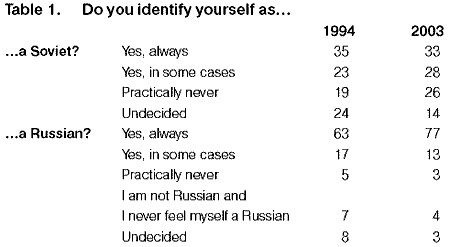
The first impression is that the “Soviet” identification has not
only endured but has become even stronger (“in some cases”).
However, the percentage of those who never consider themselves
“Soviet” has also increased at the expense of those who were
earlier undecided. The simultaneous growth of the “Russian”
identification can be explained by changes in the official
language, documents, etc.
Let’s have a closer look at the “Soviet”
self-identification.
The youngest respondents less frequently ranked themselves among
“Soviets;” more often they do not use such identification at all.
In the upper-age group (55 years and older), “Soviet”
identification has grown notably stronger. Similar processes have
taken place in all education groups (the only exception is the
decrease of “Soviet” self-identification among people with low
educations). At the same time, all groups besides those of the
elders have experienced a rise in the percentage of those who never
identify themselves as “Soviets,” although in various degrees.
The above tendencies reveal a demonstrative nostalgia for the
past. Meanwhile, the “Russian” self-identification, although
becoming more and more common as an everyday or official “label,”
does not mean a social identification yet; approximately two
decades of change and upheaval have not yet created the foundation
for such identification.
Let us now consider an ideologically dominant theme – the
attitude toward the “Russia for Russians” slogan.
A “Soviet” individual seems to be more connected to ideology
(both positively and negatively) than the “Russians” with regard to
the nationalistic system of values. But in both cases of
self-identification the majority tends to support the above slogan
wholeheartedly or with some reservation (“within reasonable
limits”); a negative attitude prevails only among non-Russians.
Links between the “Soviet” and “Russian” self-identifications
are rather intricate as the “Soviet” tag signifies not only the
official terminology of the former state but also its “internal”
characteristics (the social order, ideology, life habits, etc., as
they have survived in public opinion). At the same time, the
emotional and psychological content of the “Russian” tag is much
weaker since it is practically devoid of connotation. That is why
in most cases the “Russian” tag serves for the majority of the
population only as a new shell of the old “Soviet” label which, on
the whole, remains dominant. This assertion has two essential
reservations. First, only in rare cases does a numerical
predominance have a decisive significance; the influence of an
active minority in most cases is much more important. Second, a
demonstrative self-identification, as has already been mentioned
above, is not the same as real identification within a certain
group, system of values and type of conduct.
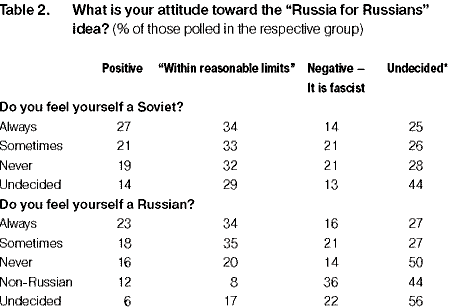
* “I do not care about it,” “I never thought about it;” the 2003
survey.
“FRIENDS” AND “FOES”: LIMITS OF SELF-ASSERTION
From the wide range of problems related to a national
self-appraisal, let’s consider only those that reveal a tendency
toward self-assertion. This is not just self-identification as a
means for distinguishing “friends” from “foes” but a search for a
self-justification and substantiation of one’s own position. The
need for self-assertion by an individual, a social community and a
nation emerges mostly in unstable, transitional situations (for
example, in the period of adolescence). For full-grown, “mature”
organisms, including social ones, self-assertion is not a
problem.
In this survey, self-assertion is best manifest in the
respondents’ answers cocerning who they are “proud” of being.
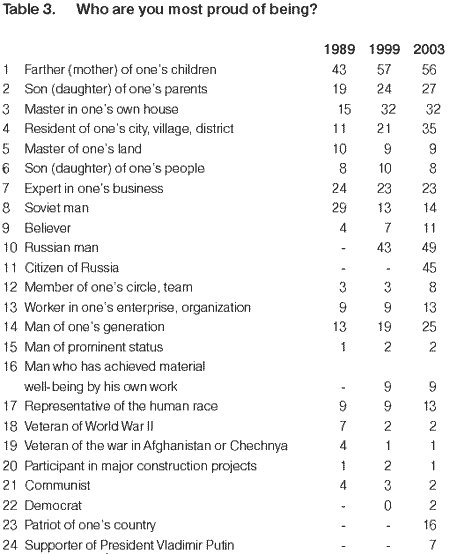
— The question was not asked in this year.
The most significant form of a man’s “proud” self-assertion is
own status of a father and/or mother. The status of being
“children” (younger generation) has a notably weaker impact and is
witnessed mostly among people aged 15 to 25 years. Another
widespread factor of self-assertion comes from belonging to the
“Russian people” (Point 10); almost equally significant is the
status of “citizen of Russia” (Point 11). The significance of
belonging to “Soviet” people decreased considerably by 1999 and has
remained unchanged since then; this characteristic is important
mostly to upper-age groups. The growth of self-assertion through
pride in one’s native place (Point 4 – “local man,” citizen of
one’s city; as well as Point 5 – “master in one’s own house”) is
also significant as it corresponds to a widespread (43 percent in
2003) link between the notion of one’s people and the place of
one’s birth. Pride in one’s homeland (Point 23) is now mentioned
twice as seldom. More and more people take pride in their
generation (Point 14) as a way of promoting their self-assertion;
the percentage of these people is the highest among the youngest
(33 percent among 15 to 25-year olds) and the oldest (29 percent).
The low percentage of people who say the status of “veteran of
World War II” promotes their self-assertion is explainable by
natural reasons, while the small percentage with regard to the
status of veterans of the Afghan and Chechen wars can be explained
by a public re-assessment of the two conflicts.
Now let’s take a look at ethnic self-appraisals, which can be
viewed from a certain angle as factors of self-assertion.
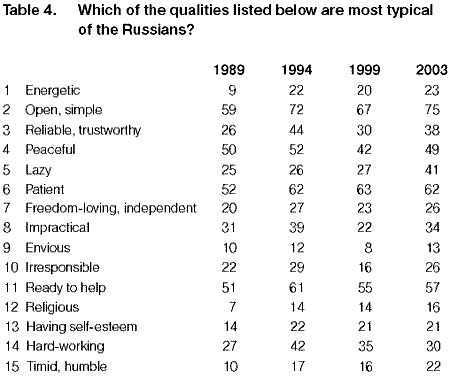
The constants which appear in this part of the survey –
peacefulness, patience, self-dignity, readiness to help – are
positive strong points indicative of the Russian people’s
self-assertion (we do not discuss here as to what extent they are
really justified). As for the obviously unsteady characteristics,
they include rather notable pairs of seemingly interconnected
polarities. One of them belongs to the “external” characteristics
of a group’s position: love of freedom has become relatively more
widespread (as compared with its decrease in 1999); at the same
time, there has been an evident increase in the frequency of
mentioning “timid and humble” qualities. Incidentally, 86 percent
of those polled said that being “humble” was connected to
“simplicity,” while 77 percent linked humbleness to patience.
Of special interest are pairs of features belonging to the
“inner” characteristics of a group and to peculiarities of its
behavior. Today, much fewer people mention diligence, while many
lay emphasis on laziness. Interestingly, this quality is connected
with being impractical and irresponsible, as well as “simple and
open.” In general, this set of characteristics paints a social
“self-portrait” of an individual who is simple and kind, lazy and
irresponsible, impractical and constantly humiliated by somebody.
In Russian, the word sovok is used to explain this type of ironic
self-description. It is, simultaneously, a means of
self-humiliation and self-justification or, to be more exact, a
self-assertion through a demonstrative self-disparagement. Thus,
people habitually set deliberately low levels of social aspiration,
and refuse to orient themselves to higher, more civilized types (as
Dostoevsky wrote, “try to love us when we are black,” which means
that “we” love ourselves in this capacity and we are not going to
transform into something different).
“GENERALIZED FOE”
In a situation where traditional barriers (social, cultural,
state-imposed and everyday) between countries, peoples and groups
increasingly erode, social identification often gives rise to
attempts to build artificial obstacles at various levels, including
inside the mass consciousness. These attempts are greeted with
strong support from politicians, ideologists and advocates of
patriotic isolationist doctrines.
The simplest and most common form of self-assertion in such
conditions is to lower the perception of different cultures,
traditions, orientations, etc. The “different” is portrayed as
something alien and unacceptable as a universal model. Furthermore,
as seen from the public opinion polls, the image of a “foe” is
generalized, and includes competitors, enemies, breakers of the
peace and traditions, etc. More importantly, this attitude is
assumed to all “alien” phenomena. (It is worth remembering that the
Greek word xenophobia literally means fear of foreigners or
strangers.)
At the end of 2002, following the terrorist attack at the
Dubrovka Theater in Moscow, the attitudes toward representatives of
various ethnic groups worsened. Following this tragedy, it is
perhaps easy to understand why the percentage of the Russian
population who felt irritation, dislike, distrust and fear toward
the Chechen people increased from 53 percent (in 2000) to 66
percent. The same thing happened in people’s attitudes toward
gypsies (from 43 to 52 percent), Azerbaijanis (from 29 to 39
percent), Americans (from 10 to 17 percent), Arabs (from 15 to 28
percent), Jews (from 12 to 15 percent), Germans (from 6 to 11
percent) and Japanese (from 5 to 9 percent). It is as though the
experience of a sharp pain in one part of the body makes it feel as
though the entire body is hurting. A year later, at the end of
2003, the intensity of the pain subsided somewhat, and the level of
negative attitudes toward the above groups decreased [Public
Opinion in 2003. Moscow: VTSIOM-A, 2003, pp. 65-66.]
Attitudes toward non-traditional groups reveal controversial
dynamics.
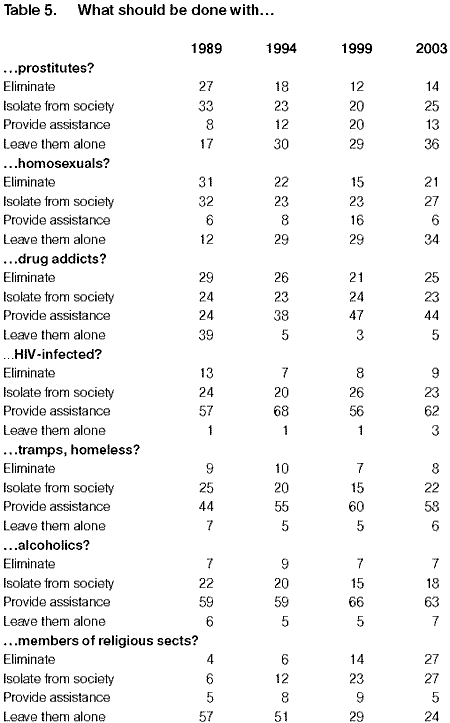
The immediate cause of the striking public animosity toward
religious sects is clear: the “friendly” patriarchal Orthodox
Church is being granted state status in the country (which is
admitted by mass media and public opinion), making other
confessions (Catholics, sect members, members of the Hare Krishna
movement, and others) “foes” and subjected to various restrictions.
Although only 22 percent (against 50) want privileges for the
“church of the majority,” up to 34 percent of this number support
the “elimination” of sect members.
Similar changes have taken place in people’s attitudes,
especially in large Russian cities, toward migrants from the North
and South Caucasus, from the former Soviet Central Asia, and from
the Far East. For the authorities and the common man, these peoples
are “aliens,” dangerous and uncontrolled. That is why the prevalent
reaction to migration remains in the form of prohibitions and
barriers (which, however, are easily overcome by traditional
bribes). According to the 2003 survey, 58 percent of those polled
described irritation, dislike or fear toward “migrants from
southern republics” living in their town or district. Sixty-six
percent (against 22 percent) would accept restrictions against
people of “non-Russian nationality” attempting to enter their
country, while 58 percent (against 22 percent) would forbid
“newcomers from the Caucasus” from remaining in their town or
district.
There is yet another method of achieving self-assertion,
proposed officially since Soviet times and largely accepted by
public opinion, and that is by belittling the image of an external
“enemy.” To justify its actions in Chechnya, the Russian government
first used the traditional and ineffective slogan of
“non-interference in its home affairs;” after 9/11, that rallying
cry was replaced with a new and equally ineffective slogan of
“anti-terrorist coalition.” Following the beginning of U.S.
military operations in Iraq, especially after the aggravation of
the situation there in the spring of 2004, Russia’s mass media
showered the country with articles and commentaries intended to
prove that the coalition forces were acting in the occupied country
even more crudely and inefficiently than the Russian forces were in
the Caucasus.
MAN AND THE STATE: A “SLY” SYMBIOSIS
Surveys of recent years, for example those conducted during the
election campaigns of 2003 and 2004, invariably prove Russians’
strong trust in people in power. But the dynamics concerning the
people’s “moral” link with the state reveal a completely different
tendency.
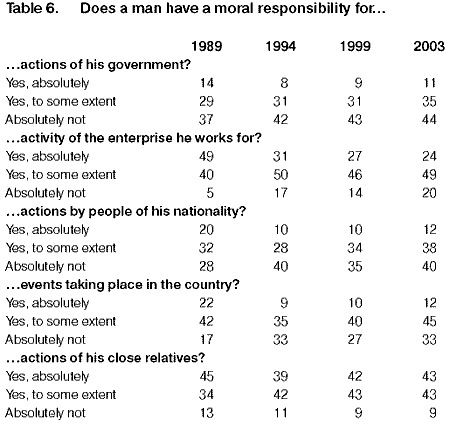
There are almost no changes as regards “close relatives.” In all
of the other cases the feeling of moral responsibility is now
weaker than it was 15 years ago. This means that the authorities
and the population are becoming more and more estranged from each
other. This change is particularly manifest among the youngest
citizens. In 2003, “absolute responsibility for their government’s
action” was recognized by 13 percent of elderly people (55 years
and older) and 9 percent of the youngest respondents. In 1989, the
respective figures were 22 and 11 percent. Twenty-six percent of
elderly people now deny their responsibility for developments in
the country (as compared with 14 percent in 1989); for young
people, this figure stands at 36 percent (22 percent in 1989).
Hence the justification of the population’s sly “game” with the
state: the ever-growing number of Russian people considers it
rightful not to fulfill their responsibilities to the state.
According to the 1999 survey, 48 percent of those polled saw
nothing or almost nothing reprehensible in dodging military
service; in 2003, the same opinion was shared by 52 percent. In
1999, 58 percent (64 percent in 2003) did not censure the act of
riding without ticket on municipal transport, while the concealment
of income so as to avoid paying taxes was defended by 42 percent in
1999 and 46 percent in 2003.
As before, people’s mischievous “games” with the state
inevitably go hand in hand with the mischievous “games” they play
with themselves – deals with one’s own conscience, deliberately
sinful deeds.
To sum up, the twenty years that have passed since the start of
reforms in Russian society have not resulted in the emergence of a
“new” (contemporary, European, democratic, civic) base for
self-identification, to say nothing of the self-assertion, of the
Russian people. That is why characteristics of the Soviet man
remain the real reference point. This tendency is supported by an
official search for a “Soviet” legitimization through the symbols,
style and governmental methods of the Soviet era. Simultaneously,
features of different periods are combined: victorious wartime
marches and the stability of the “stagnation” period,
administrative reshuffles in the Khrushchev style and the
arbitrariness of the perestroika years, etc. Still relevant is the
mechanism of “negative” self-assertion, typical of the Soviet
times, through the belittlement of the “enemy” or “generalized
foe.” However, the mass consciousness is becoming increasingly
alienated from the government and the state, while attempts to
identify with their values uncover mischievousness and ambiguity
amongst the populace. It seems that the Russian people need the
protection of the state but they do not want to serve it.









